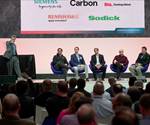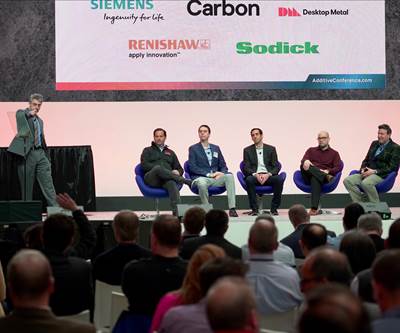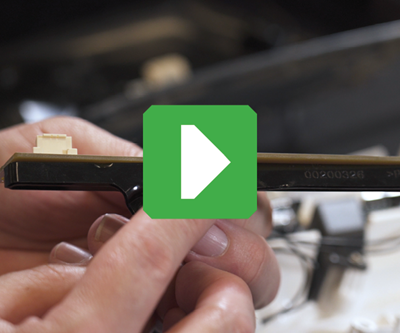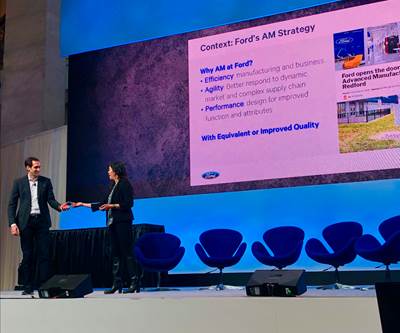Video: Can 3D Printed Parts Hold Self-Tapping Screws?
Automotive light maker Varroc Lighting Systems will soon begin using additive manufacturing for plastic production parts fastened into assemblies. Here are the results of its tests with self-tapping screws.
Production parts need fasteners. This point might seem basic, but it is a factor that will affect whether additive manufacturing (AM) can advance into large-scale production. In this video, Varroc Lighting Systems describes the findings of its experiments with fastening polymer 3D printed parts, specifically test pieces made of Carbon’s EPX 82 epoxy and HP’s PA12-GB nylon.
Transcript
Peter Zelinski, Additive Manufacturing
To make production parts, that implies assembly, and the need to work with these 3D printed components in assembly is what got you thinking about fasteners, thinking about screws. Talk to me about the experimentation you’ve done related to fastening.
Dylan Schickel, Varroc Lighting Systems
My job in our company is working on new manufacturing processes and innovation, and any time I’m looking at a new process I have to get down to the nuts and bolts….
Peter Zelinski
So to speak.
Dylan Schickel
Exactly. To understand, where are the limitations. What’s the state of the art? When we started looking at these 3D printing processes and trying to understand how can we make useful end parts, we realized there was actually something missing at the nuts-and-bolts level. Historically people who use rapid prototyping processes might glue parts together. They might sometimes with really big fasteners print some threads. They might use brass inserts: Much as we see here, we can put brass inserts in plastic very well and it works really nice. The challenge with that is it’s not easy to imagine industrializing that in a cost-competitive way.
So, we said, why can’t we use what we already know? We use a lot of screws in the 3 to 4-mm range. They’re self-tapping screws. We said, OK, let’s make some bosses with self-tapping screws. Let’s find out what works and what doesn’t work. We did kind of a detailed technique that we know from our injection molding background where we will drive the fastener using a torque-controlled tool. We’ll graph the curve to understand how it works, understand how it threads together, what the retention torque is, what the stripping torque is, and going through all of that detail work. And from the initial work, it looks like the self-tapping screws worked just fine.
Then we said, we need to know something about the process window. So we reached out to a couple of our partners, Carbon directly and 3D Parts Unlimited for HP Multi Jet Fusion parts. They printed some of these boss plates for us. We tested varying diameters. We tested multiple replicates so we could get a statistical sample size and we’re able to understand what the process window is and what the design window is for driving self-tapping screws, particularly in Carbon DLS and HP MJF parts.
AM 101: What is Multi Jet Fusion?
Peter Zelinski
You told me about how you discovered actually a 3D printed boss has the potential to hold a self-tapping screw better than an injection molded one.
Dylan Schickel
It was really surprising for us. On the small end of the boss diameter, we didn’t get breakage. What happens in the injection mold is the boss, which is essentially a hollow cylinder, is formed by a part of the mold called the core pin. When the plastic melt flows around it on the far side, the melt knits together. We get what’s called the knit line and that knit line can be a weak point. But it turns out, with the printed bosses, there’s no knit line. By the fundamentals of the process, we’re building them in layers and we tried Z direction, we tried X direction — it didn’t matter. We found out that with these processes the material properties were actually in a certain way a little more isotopic than even the injection molded parts.
Related Content
How Norsk Titanium Is Scaling Up AM Production — and Employment — in New York State
New opportunities for part production via the company’s forging-like additive process are coming from the aerospace industry as well as a different sector, the semiconductor industry.
Read MoreVulcanForms Is Forging a New Model for Large-Scale Production (and It's More Than 3D Printing)
The MIT spinout leverages proprietary high-power laser powder bed fusion alongside machining in the context of digitized, cost-effective and “maniacally focused” production.
Read More10 Important Developments in Additive Manufacturing Seen at Formnext 2022 (Includes Video)
The leading trade show dedicated to the advance of industrial 3D printing returned to the scale and energy not seen since before the pandemic. More ceramics, fewer supports structures and finding opportunities in wavelengths — these are just some of the AM advances notable at the show this year.
Read MoreMultimaterial 3D Printing Enables Solid State Batteries
By combining different 3D printing processes and materials in a single layer, Sakuu’s Kavian platform can produce batteries for electric vehicles and other applications with twice the energy density and greater safety than traditional lithium-ion solutions.
Read MoreRead Next
Recap: The Additive Manufacturing Workshop for Automotive
The inaugural AM Workshop for Automotive at the North American International Auto Show brought together the world’s top automotive and additive manufacturing technology experts on one stage. Here’s what they had to say.
Read MoreVideo: Additive Manufacturing Expands Design Possibilities for Automotive Lighting
Automotive lighting maker Varroc Lighting Systems describes the impact 3D printing instead of injection molding will have on car features such as headlights.
Read MoreFord in Production with On-Demand AM Polymer Parts
Ford and Carbon presented the first digitally manufactured polymer parts in production for the Ford Motor Company, created with Carbon’s digital light synthesis technology.
Read More














.jpg;maxWidth=300;quality=90)










